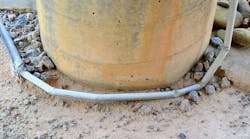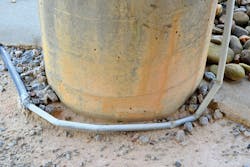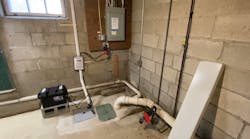All references are based on the 2017 edition of the NEC.
Bending the PVC Bending Rules
Apparently, this installer did not care about following the PVC conduit bending rules spelled out in Sec. 352.24. Field-made bends are supposed to be made with equipment identified for that specific purpose, such as PVC heating boxes, heating blankets, and heating guns, as well as spring-type benders or other mechanical-type benders. These bends look as though the installer simply tried to bend the conduit over his knee. Regardless of whatever method was used to make these bends, the end result was conduit that is kinked and pinched to the point where it would be nearly impossible to pull wires through it. Bends must be made so the conduit will not be damaged, and the internal diameter of the conduit will not be reduced.
On another note, the lack of any supports or clips on this conduit is an obvious violation of Sec. 352.30. The installer also made an interesting transition to HDPE conduit as well by simply shoving the PVC conduit into the HDPE conduit and wrapping it with some duct tape. Who needs couplings, right? I don’t think that conduit transition will remain weathertight, waterproof, or suitable for this outdoor wet location.
Guardrail Goof Up
Oops! It looks like somebody either did not read the plans correctly or did not properly measure prior to this installation.
I spotted this catastrophe on a recent visit to the great state of Maine. It’s an area that I have visited on several other occasions. On this particular trip, I noticed a new guard rail had been installed along this pedestrian bridge. I also noticed that somebody goofed up.
The old guardrail did not obstruct the receptacle installed in the picture, but the new one sure does. As shown in the photo, the receptacle is virtually useless now, since it would be almost impossible to plug anything into it.
The enclosure is no longer in compliance with Sec. 406.9(B) because the cover cannot be closed. The guardrail section will need to be cut back, or the receptacle will need to be relocated in order to fix this problem. Section 406.9(B)(2)(a) requires this wet location to have a receptacle enclosure that is weatherproof in-use when it is unattended. Section 406.9(B)(2)(b) requires this receptacle to be weatherproof when nothing is plugged in. It’s presently impossible to comply with either of those Code rules.






